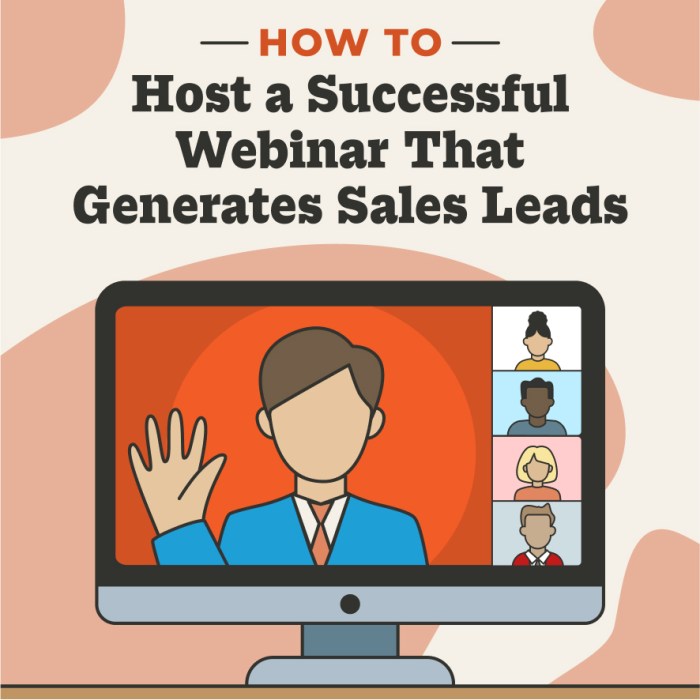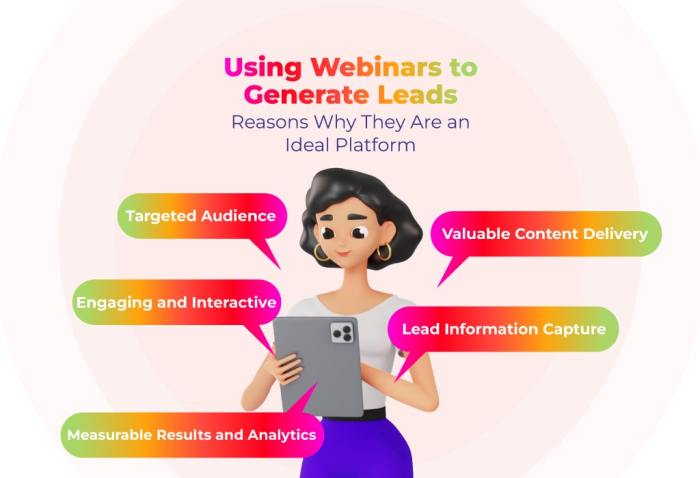Creating Webinars for Leads introduces a dynamic approach to attracting potential leads through interactive online seminars. Dive into the world of webinar lead generation and discover the key strategies for success.
Understanding Webinars for Lead Generation
Webinars are online seminars or presentations that businesses use to attract potential leads by providing valuable information, showcasing their expertise, and engaging with the audience in real-time. These virtual events allow companies to connect with their target audience, build brand awareness, and collect contact information for follow-up.
Benefits of Webinars for Lead Generation
- Interactive Engagement: Webinars offer a platform for real-time interaction with potential leads through Q&A sessions, polls, and live chats.
- Lead Qualification: By participating in a webinar, attendees self-qualify themselves as interested prospects, making them warmer leads for further nurturing.
- Content Repurposing: Webinar recordings can be repurposed into other forms of content like blog posts, social media clips, or email newsletters, extending the reach and impact of the event.
- Data Collection: Registration forms for webinars collect valuable contact information from attendees, enabling businesses to follow up with personalized communication.
Comparison with Other Lead Generation Techniques
- Webinars vs. Whitepapers: While whitepapers offer in-depth information, webinars provide a more engaging and interactive experience for leads.
- Webinars vs. Email Campaigns: Webinars allow for direct interaction and immediate feedback, unlike email campaigns that may have lower engagement rates.
- Webinars vs. Social Media Ads: Webinars offer a longer-form content format that allows for detailed explanations and demonstrations, whereas social media ads are more suited for quick and concise messages.
- Webinars vs. Networking Events: Webinars enable businesses to reach a wider audience without geographical limitations, unlike networking events that require physical presence and limited reach.
Planning Webinars for Lead Generation

When it comes to planning a webinar for lead generation, there are several key steps that you need to consider in order to make it a success. From choosing the right topic to setting clear goals and objectives, each step plays a crucial role in attracting and converting leads.
Choosing the Right Topic for a Webinar
- Consider your target audience: Think about the pain points, interests, and needs of your ideal customers. Choose a topic that addresses these issues and provides value to them.
- Stay relevant: Select a topic that is related to your products or services. This will help you attract leads that are genuinely interested in what you have to offer.
- Research trending topics: Look for popular industry trends or current events that are relevant to your audience. This can help you capture their attention and increase attendance.
Setting Goals and Objectives for a Lead Generation Webinar
- Define your objectives: Determine what you want to achieve with the webinar. Whether it’s generating a certain number of leads, increasing brand awareness, or driving sales, make sure your goals are specific and measurable.
- Establish KPIs: Identify key performance indicators that will help you track the success of your webinar. This could include metrics like registration rates, attendance rate, engagement levels, and lead conversion rates.
- Create a timeline: Set a timeline for your webinar planning process, including deadlines for promotional activities, content creation, and technical setup. This will help you stay organized and on track to meet your goals.
Creating Compelling Webinar Content: Creating Webinars For Leads
When it comes to creating compelling webinar content that attracts leads, it’s essential to focus on engaging your audience from start to finish. One powerful way to do this is through storytelling. By incorporating storytelling into your webinar content, you can create a more emotional connection with your audience, which can lead to increased engagement and interest in your message. Additionally, structuring your webinar in a way that maximizes lead generation impact is crucial. This involves planning out your content in a strategic manner that keeps your audience hooked and encourages them to take action.
Strategies for Creating Engaging Content
- Start with a strong hook to grab your audience’s attention right from the beginning.
- Use visuals, such as slides or videos, to enhance your storytelling and keep your audience visually engaged.
- Incorporate interactive elements like polls, Q&A sessions, or live chats to encourage audience participation.
- Provide valuable and actionable information that is relevant to your audience’s interests and pain points.
Importance of Storytelling in Webinar Content, Creating Webinars for Leads
Storytelling helps create a connection with your audience by evoking emotions and making your content more memorable.
- Use personal anecdotes or case studies to illustrate key points and make your content relatable.
- Weave a narrative throughout your webinar that keeps your audience engaged and invested in the story.
Structuring a Webinar for Maximum Lead Generation Impact
- Begin with a brief introduction to set the stage and establish credibility with your audience.
- Artikel the key points you will cover in the webinar to give your audience a roadmap of what to expect.
- Break up your content into digestible chunks with clear transitions to keep your audience engaged.
- End with a strong call to action that prompts your audience to take the next step, whether it’s signing up for a demo, downloading a resource, or scheduling a call.
Promoting Webinars to Generate Leads

To successfully generate leads through webinars, it is crucial to effectively promote them across various channels. This involves leveraging social media platforms, creating engaging content, and optimizing landing pages to capture potential leads.
Different Channels for Promoting Webinars
- Utilize email marketing campaigns to reach out to your existing subscribers and notify them about upcoming webinars.
- Collaborate with industry influencers or partners who can help promote your webinar to their audience.
- Utilize paid advertising on platforms like Google Ads or social media to target specific audiences interested in your webinar topic.
- Promote your webinar on relevant online communities, forums, and discussion groups where your target audience is active.
Role of Social Media in Webinar Promotion
Social media plays a vital role in webinar promotion by allowing you to reach a large audience and engage with potential leads. Utilize platforms like LinkedIn, Twitter, Facebook, and Instagram to share teaser content, create event pages, and run targeted ads to attract participants to your webinar.
Tips for Creating an Effective Landing Page
Ensure your landing page is visually appealing, easy to navigate, and clearly highlights the benefits of attending your webinar.
- Include a compelling headline and a concise description of what participants can expect from the webinar.
- Use high-quality images or graphics related to the webinar topic to capture the audience’s attention.
- Add a registration form with minimal fields to reduce friction and make it easy for visitors to sign up.
- Include social proof such as testimonials or past attendee feedback to build credibility and trust.
- Add a clear call-to-action button that stands out and prompts visitors to register for the webinar.
Engaging with Leads During Webinars
When it comes to webinars for lead generation, engaging with attendees is crucial for converting them into potential leads. Audience engagement not only keeps participants interested but also helps in building relationships and trust with them. Here are some techniques and interactive elements to consider incorporating in your webinars:
Interactive Q&A Sessions
- Encourage attendees to ask questions throughout the webinar.
- Allocate time for a dedicated Q&A session at the end of the presentation.
- Address each question personally to show attentiveness and expertise.
Polls and Surveys
- Integrate polls and surveys to gather feedback and opinions from participants.
- Use the data collected to tailor future content and offers to meet attendees’ needs.
- Show real-time results to keep the audience engaged and interested.
Interactive Chat Feature
- Enable a chat feature for participants to interact with each other and the presenter.
- Encourage networking and discussions to create a sense of community during the webinar.
- Respond to chat messages promptly to foster a dynamic and engaging environment.